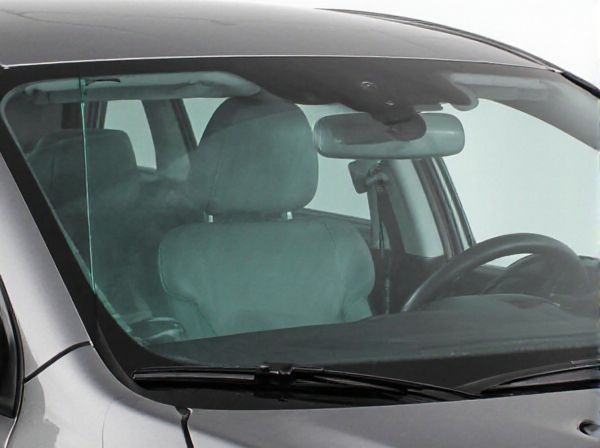
Photo illustration: Gorilla Glass Windshield vs Traditional Glass Windshield
Gorilla Glass windshields offer greater durability and scratch resistance compared to traditional glass windshields, enhancing overall vehicle safety and longevity. They are lighter in weight, which can improve fuel efficiency and handling. Choosing a Gorilla Glass windshield for your vehicle ensures stronger impact protection and better visibility over time.
Table of Comparison
| Feature | Gorilla Glass Windshield | Traditional Glass Windshield |
|---|---|---|
| Material Composition | Chemically strengthened aluminosilicate glass | Laminated soda-lime glass |
| Durability | High scratch resistance and impact strength | Moderate durability, prone to scratches |
| Weight | Lighter by up to 30% | Heavier, standard weight |
| Clarity | Superior optical clarity with anti-reflective properties | Standard clarity, more prone to glare |
| Safety | Enhanced shatter resistance, reduces injury risk | Shatters more easily, higher injury risk |
| Cost | Higher initial cost | Lower initial cost |
| Lifespan | Longer lifespan, less frequent replacements | Shorter lifespan, more maintenance |
Introduction to Gorilla Glass and Traditional Windshields
Gorilla Glass windshields feature an advanced aluminosilicate composition that offers superior scratch resistance and impact durability compared to traditional laminated glass windshields made from multiple layers of glass and plastic interlayers. Traditional windshields provide basic safety by preventing shattering upon impact, while Gorilla Glass enhances visual clarity and reduces weight, contributing to improved fuel efficiency in modern vehicles. The integration of Gorilla Glass in automotive manufacturing represents a significant innovation in windshield technology, combining strength with lightweight performance.
Material Composition: Gorilla Glass vs Traditional Glass
Gorilla Glass windshields are made from an alkali-aluminosilicate sheet glass known for its high strength and scratch resistance, incorporating a chemically strengthened process that enhances durability. Traditional glass windshields typically consist of laminated safety glass formed by two layers of annealed glass bonded with a polyvinyl butyral (PVB) interlayer, providing impact resistance and shatter protection. The molecular structure of Gorilla Glass contributes to superior thinness and flexibility compared to the more brittle and thicker traditional laminated glass.
Strength and Durability Comparison
Gorilla Glass windshields offer superior strength and durability compared to traditional glass, featuring a chemically strengthened composition that enhances resistance to cracks and chips. Their thin yet tough structure reduces the risk of shattering upon impact, improving vehicle safety and longevity. Traditional glass windshields, typically made from laminated glass, are thicker but more prone to damage from debris and temperature fluctuations, leading to more frequent replacements.
Weight Differences and Impact on Vehicle Performance
Gorilla Glass windshields weigh up to 50% less than traditional glass windshields, significantly reducing overall vehicle weight. This weight reduction improves fuel efficiency and enhances vehicle acceleration and braking performance. Lighter windshields also contribute to better handling and reduced wear on suspension components.
Scratch and Crack Resistance
Gorilla Glass windshields offer superior scratch resistance due to their chemically strengthened aluminosilicate composition, significantly reducing surface abrasions compared to traditional laminated glass windshields. The advanced ion-exchange process enhances crack resistance, providing higher durability against impacts and thermal stress, which helps maintain structural integrity and visibility. In contrast, traditional glass windshields are more prone to chips and cracks from road debris and temperature fluctuations, often resulting in costly repairs or replacements.
Safety Features and Crash Performance
Gorilla Glass windshields offer enhanced safety features with their ultra-thin, chemically strengthened composition that provides superior impact resistance and shatter protection compared to traditional glass windshields. The advanced lamination technology in Gorilla Glass minimizes fragmentation during collisions, reducing the risk of injury from flying glass shards. Crash performance tests indicate that vehicles equipped with Gorilla Glass windshields exhibit improved structural integrity, contributing to better occupant protection in frontal and side-impact crashes.
Cost Analysis: Gorilla Glass vs Traditional Options
Gorilla Glass windshields offer enhanced durability and scratch resistance but come with a higher upfront cost compared to traditional glass windshields, which are generally more affordable and easier to replace. The long-term cost benefits of Gorilla Glass include reduced repair frequency and potential insurance savings due to its superior strength and impact resistance. Traditional glass windshields, while cheaper initially, may incur higher overall expenses over time due to increased vulnerability to chips and cracks.
Installation and Maintenance Considerations
Gorilla Glass windshields offer easier installation due to their lightweight and thinner profile, reducing labor time and potential damage during handling compared to traditional glass windshields. Maintenance requirements for Gorilla Glass are minimized as its chemically strengthened composition provides superior scratch resistance and durability, lowering replacement frequency. Traditional glass windshields necessitate more careful installation and regular maintenance to prevent chips and cracks, which can compromise visibility and safety.
Environmental Impact and Sustainability
Gorilla Glass windshields significantly reduce environmental impact by using thinner, lighter materials that lower vehicle weight and improve fuel efficiency, thus decreasing carbon emissions. Their enhanced durability extends windshield lifespan, reducing the frequency of replacements and waste compared to traditional glass. Traditional glass production demands higher energy consumption and generates more CO2 emissions, while Gorilla Glass manufacturing emphasizes sustainability with advanced, resource-efficient processes.
Which Windshield is Right for You?
Gorilla Glass windshields offer enhanced durability, scratch resistance, and lighter weight compared to traditional glass windshields, making them ideal for drivers seeking improved performance and safety. Traditional glass windshields tend to be more cost-effective and easier to repair or replace, suitable for budget-conscious consumers or older vehicle models. Evaluating your priorities for strength, maintenance costs, and vehicle type will help determine whether Gorilla Glass or traditional glass is the right windshield choice for your needs.
 caratoz.com
caratoz.com